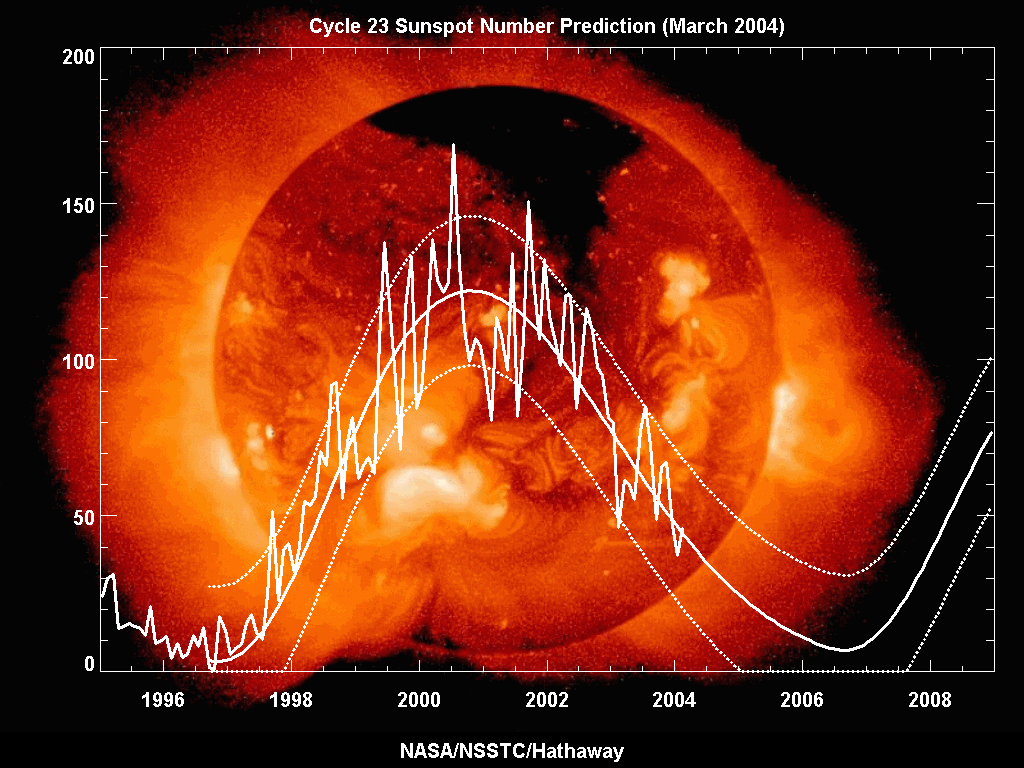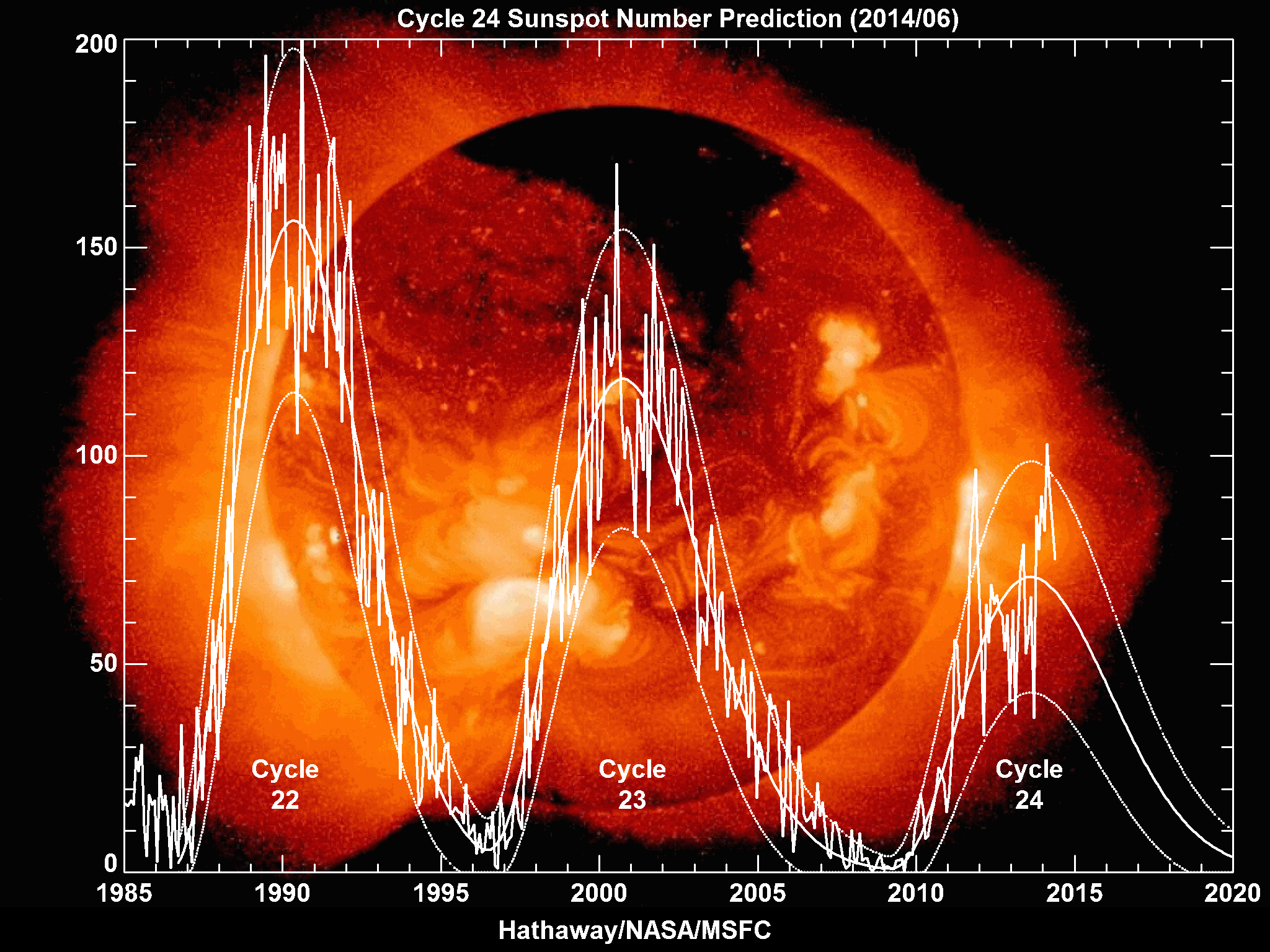|
Modern Maximum
The Modern Maximum, refers to the period of relatively high solar activity which began with solar cycle 15 in 1914. It reached a maximum in solar cycle 19 during the late 1950s and may have ended with the peak of solar cycle 23 in 2000, as solar cycle 24 is recording, at best, very muted solar activity. Another proposed end date for the maximum is 2007, with the decline phase of Cycle 23. In any case the low solar activity of solar cycle 24 in the 2010s marked a new period of reduced solar activity. This maximum period is a natural example of solar variation The solar cycle, also known as the solar magnetic activity cycle, sunspot cycle, or Schwabe cycle, is a nearly periodic 11-year change in the Sun's activity measured in terms of variations in the number of observed sunspots on the Sun's surfac ..., and one of many that are known from proxy records of past solar variability. The Modern Maximum reached a double peak once in the 1950s and again during the 1990s. Referenc ... [...More Info...] [...Related Items...] OR: [Wikipedia] [Google] [Baidu] |
Sunspot Numbers
Sunspots are phenomena on the Sun's photosphere that appear as temporary spots that are darker than the surrounding areas. They are regions of reduced surface temperature caused by concentrations of magnetic flux that inhibit convection. Sunspots appear within active regions, usually in pairs of opposite magnetic polarity. Their number varies according to the approximately 11-year solar cycle. Individual sunspots or groups of sunspots may last anywhere from a few days to a few months, but eventually decay. Sunspots expand and contract as they move across the surface of the Sun, with diameters ranging from to . Larger sunspots can be visible from Earth without the aid of a telescope. They may travel at relative speeds, or proper motions, of a few hundred meters per second when they first emerge. Indicating intense magnetic activity, sunspots accompany other active region phenomena such as coronal loops, prominences, and reconnection events. Most solar flares and coronal mas ... [...More Info...] [...Related Items...] OR: [Wikipedia] [Google] [Baidu] |
Solar Cycle 15
Solar cycle 15 was the fifteenth solar cycle since 1755, when extensive recording of solar sunspot activity began. The solar cycle lasted 10.1 years, beginning in July 1913 and ending in August 1923. The maximum smoothed sunspot number observed during the solar cycle was 175.7 (August 1917), and the starting minimum was 2.5.SIDC Monthly Smoothed Sunspot Number. During the minimum transit from solar cycle 15 to 16, there were a total of 534 days with no sunspots.Spotless Days.Solaemon's Spotless Days Page. History Geomagnetic storms in March 1918, August 1919, October 1919, and March 1920 affected telegraph lines, while a solar flare on 13 May 1921 also affected rail signal and switching equipment, in what was known as the "New York Railroad Storm." 1921 A May 1921 geomagnetic storm, major geomagnetic storm during 13–15 May 1921 caused damage in communication systems and aurora displays in much of the eastern United States. In Sweden, the event caused major disruptions to the te ... [...More Info...] [...Related Items...] OR: [Wikipedia] [Google] [Baidu] |
Solar Cycle 19
Solar may refer to: Astronomy * Of or relating to the Sun ** Solar telescope, a special purpose telescope used to observe the Sun ** A device that utilizes solar energy (e.g. "solar panels") ** Solar calendar, a calendar whose dates indicate the position of the Earth on its revolution around the Sun * Solar Maximum Mission The Solar Maximum Mission satellite (or SolarMax) was designed to investigate Sun, Solar phenomena, particularly solar flares. It was launched on February 14, 1980. The SMM was the first satellite based on the Multimission Modular Spacecraft bus ..., a satellite * SOLAR (ISS), an observatory on International Space Station Music * Solar (composition), "Solar" (composition), attributed to Miles Davis * Solar (Red Garland album), ''Solar'' (Red Garland album), 1962 * Solar (Taeyang album), ''Solar'' (Taeyang album), 2010 * ''Solar'', a 2011 album by Rubik (band), Rubik * "Solar", a song by Northlane from ''Mesmer (Northlane album), Mesmer'', 2017 * SOLAR ... [...More Info...] [...Related Items...] OR: [Wikipedia] [Google] [Baidu] |
Solar Cycle 23
Solar cycle 23 was the 23rd solar cycle since 1755, when extensive recording of solar sunspot activity began. The solar cycle lasted 12.3 years, beginning in August 1996 and ending in December 2008. The maximum smoothed sunspot number observed during the solar cycle was 180.3 (November 2001), and the starting minimum was 11.2. During the minimum transit from solar cycle 23 to 24, there were a total of 817 days with no sunspots. Compared to the last several solar cycles, it was fairly average in terms of activity. History Large solar flares and coronal mass ejections (CMEs) occurred on 7 September 2005 (X17), 15 April 2001 (X14.4) and 29 October 2003 (X10), with auroras visible in mid-latitudes. 2000 One of the first major aurora displays of solar cycle 23 occurred on 6 April 2000, with bright red auroras visible as far south as Florida and South Europe. On 14 July 2000, the CME hurled by a X5.7 solar flare provoked an extreme (G5 level) geomagnetic storm the next day. Known ... [...More Info...] [...Related Items...] OR: [Wikipedia] [Google] [Baidu] |
Solar Cycle 24
Solar cycle 24 is the most recently completed solar cycle, the 24th since 1755, when extensive recording of solar sunspot activity began.Kane, R.P. (2002).Some Implications Using the Group Sunspot Number Reconstruction. ''Solar Physics'' 205(2), 383-401. It began in December 2008 with a minimum smoothed sunspot number of 2.2, and ended in December 2019. Activity was minimal until early 2010. It reached its maximum in April 2014 with a 23 months smoothed sunspot number of 81.8. This maximum value was substantially lower than other recent solar cycles, down to a level which had not been seen since cycles Solar cycle 12, 12 to Solar cycle 15, 15 (1878-1923). Predictions Prior to the minimum between the end of Solar Cycle 23 and the beginning of Solar Cycle 24, two theories predicted how strong Solar Cycle 24 would be. One camp postulated that the Sun retained a long memory (Solar Cycle 24 would be active) while the other asserted that it had a short memory (quiet). Prior to 2006, th ... [...More Info...] [...Related Items...] OR: [Wikipedia] [Google] [Baidu] |
Solar Variation
The solar cycle, also known as the solar magnetic activity cycle, sunspot cycle, or Schwabe cycle, is a nearly periodic 11-year change in the Sun's activity measured in terms of variations in the number of observed sunspots on the Sun's surface. Over the period of a solar cycle, levels of solar radiation and ejection of solar material, the number and size of sunspots, solar flares, and coronal loops all exhibit a synchronized fluctuation from a period of minimum activity to a period of a maximum activity back to a period of minimum activity. The magnetic field of the Sun flips during each solar cycle, with the flip occurring when the solar cycle is near its maximum. After two solar cycles, the Sun's magnetic field returns to its original state, completing what is known as a Hale cycle. This cycle has been observed for centuries by changes in the Sun's appearance and by terrestrial phenomena such as aurora but was not clearly identified until 1843. Solar activity, driven by b ... [...More Info...] [...Related Items...] OR: [Wikipedia] [Google] [Baidu] |
20th Century
The 20th (twentieth) century began on January 1, 1901 ( MCMI), and ended on December 31, 2000 ( MM). The 20th century was dominated by significant events that defined the modern era: Spanish flu pandemic, World War I and World War II, nuclear weapons, nuclear power and space exploration, nationalism and decolonization, technological advances, and the Cold War and post-Cold War conflicts. These reshaped the political and social structure of the globe. The 20th century saw a massive transformation of humanity's relationship with the natural world. Global population, sea level rise, and ecological collapses increased while competition for land and dwindling resources accelerated deforestation, water depletion, and the mass extinction of many of the world's species and decline in the population of others. Global heating increased the risk of extreme weather conditions. Additional themes include intergovernmental organizations and cultural homogenization through developments in em ... [...More Info...] [...Related Items...] OR: [Wikipedia] [Google] [Baidu] |
2000s
File:2000s decade montage3.png, From top left, clockwise: The World Trade Center on fire and the Statue of Liberty during the 9/11 attacks in 2001; the euro enters into European currency in 2002; a statue of Saddam Hussein being toppled during the Iraq War in 2003, and in 2006, Hussein would be executed for crimes against humanity; U.S. troops heading toward an army helicopter in Afghanistan during the War on Terror; social media through the Internet spreads across the world; a Chinese soldier gazes at the 2008 Summer Olympics commencing in Beijing; the largest economic crisis since the Great Depression hits the world in 2008; a tsunami from the Indian Ocean earthquake kills over 230,000 in 2004, and becomes the strongest earthquake since the 1964 Alaska earthquake, 420px, thumb rect 1 1 234 178 September 11 attacks rect 236 1 371 178 Euro rect 374 1 495 90 91 181 Iraq War rect 244 181 366 326 369 181 495 War on Terror rect 327 330 494 486 Social media rect 165 330 324 4 ... [...More Info...] [...Related Items...] OR: [Wikipedia] [Google] [Baidu] |
_2007-04-30_T001456.gif)




